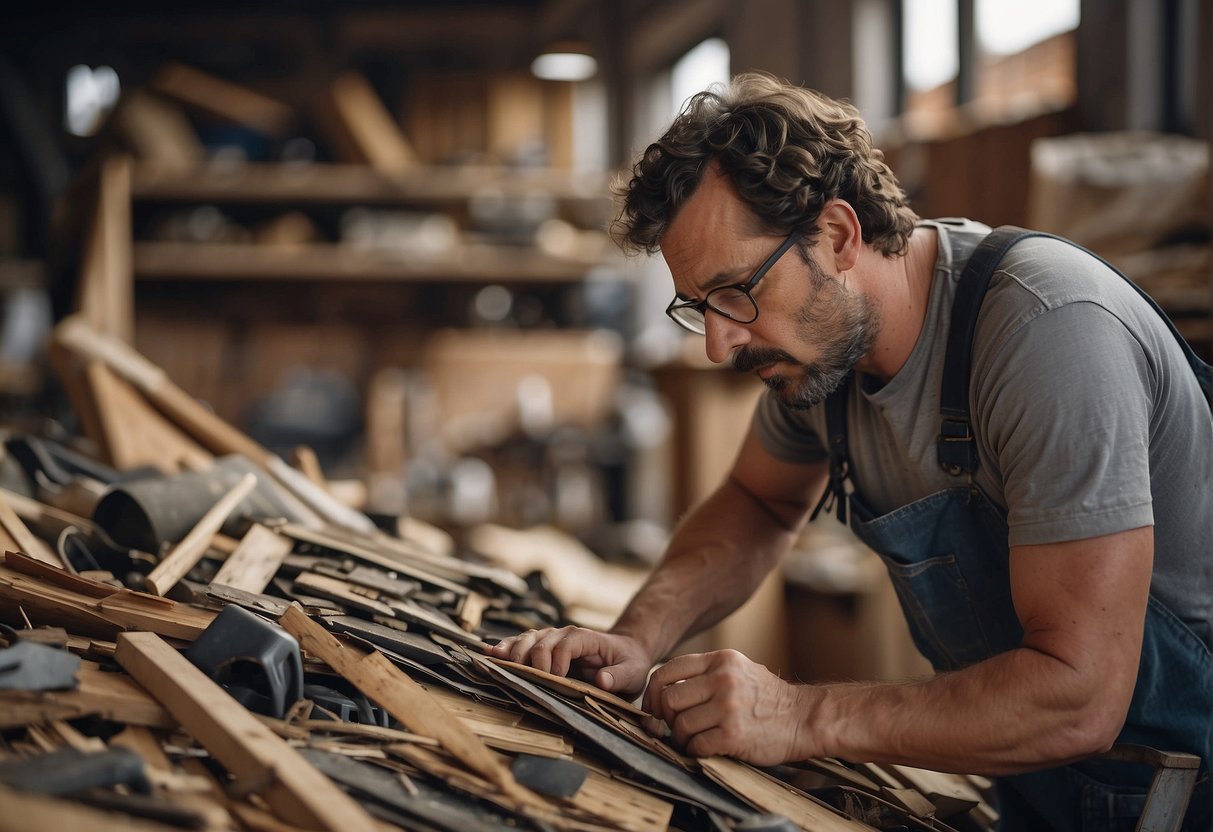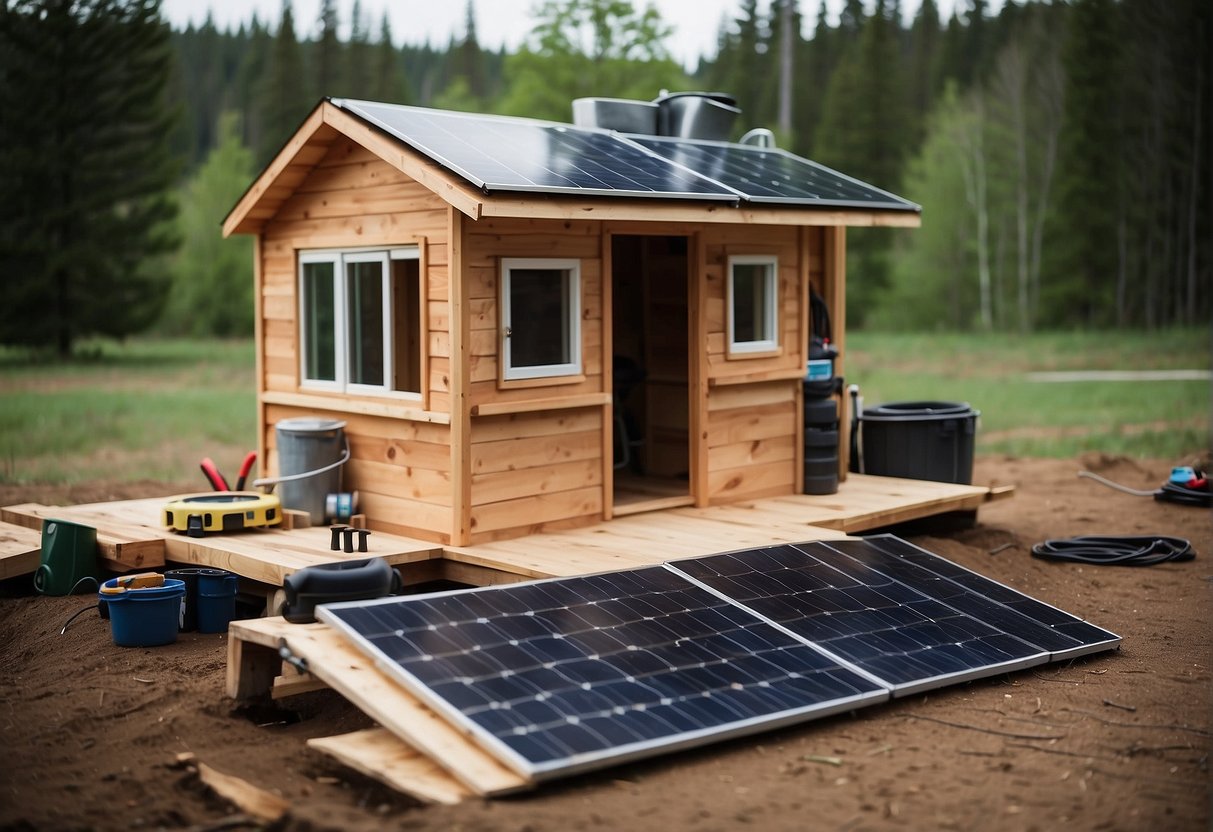Building a tiny house with no money may sound like a fairytale, but it’s not far from reality if you approach it with resourcefulness and creativity.
Embracing a minimalist lifestyle not only helps in downsizing physical possessions but also paves the way for financial freedom.
With a clear plan and determination, constructing a micro dwelling without a significant budget becomes an achievable goal.
Acquiring materials without spending money often involves seeking out donations, finding recycled materials, and sometimes bartering for goods and services.

Key project phases such as selecting a suitable location, preparing the site, and laying the foundation are critical steps that require careful attention to detail.
As you progress through the construction phase, it’s essential to stay adaptable and utilize low- or no-cost materials.
Building a tiny house without financial resources can be a testament to one’s ability to innovate and result in a unique and personal home that reflects the efforts and ingenuity involved in its creation.
Key Takeaways
- Building a tiny house with no budget demands careful planning and a minimalist approach.
- Resourcefulness in acquiring materials through donations and recycling is crucial.
- Creativity plays a key role in adapting to the construction process and material availability.
Minimalism and Planning
When you’re building a tiny house with no money, embracing minimalism and planning are your best tools.
You’ll need to downsize your possessions and design a space that maximizes utility without exceeding your budget.
Figuring out Your Needs
First things first, assess what you truly need. This includes not only what you own but also the layout of your tiny house.
Prioritize essentials and decide what you can let go. A list can look something like this:
- Must-haves: Bed, bathroom, kitchenette
- Nice-to-haves: Small work area, fold-down table
- Unnecessary: Excessive decor, large furniture
At this stage, it is critical to make tough choices about downsizing your belongings. Consider each item’s utility compared to the space it occupies.
Designing Your Tiny House Plan
A well-thought-out design is the foundation of your tiny house.
With no money in the budget, your floor plan needs to be streamlined for efficiency. Here are steps to create your tiny house plan:
- Measure: Determine the dimensions of your buildable area.
- Sketch: Start with basic shapes to layout your essentials. Remember, simplicity is key.
- Incorporate Multi-Functionality: Plan for items like a bed that folds into a couch or a table that slides out when needed. Multi-functional furniture is your friend.
- Think Vertically: Use vertical space for built-in storage like shelves or lofted sleeping areas.
- Refine: Adjust your plan, always considering flow and utility.
Your tiny house plan doesn’t require professional software — a pencil and paper will do. Keep it practical, and you’ll be one step closer to making your dream a reality.
Acquiring Resources Without Money

Building a tiny house on a shoestring budget hinges on acquiring the necessary materials without spending money.
Focus on salvaged materials, seek community support, and leverage your skills for bartering to keep your costs at a minimum.
Finding Salvaged Materials
Your first step is scouting for salvaged materials at local recycling centers, salvage yards, or construction sites that may have excess or used items like lumber, plywood, OSB panels, doors, and windows.
Always ask for permission before taking anything from construction sites, as taking materials without consent is illegal.
These places might allow you to take what you need for free, especially materials that are difficult to dispose of or recycle, such as large pieces of glass.
- Construction Sites: Inquire with contractors for scrap lumber.
- Salvage Yards: Look for usable doors, windows, and fixings.
- Recycling Centers: Source glass and metals that you can repurpose.
Crowdfunding and Community Support
Crowdfunding platforms can be a way to raise funds for materials. Set up a campaign explaining your project and your goal to build a sustainable tiny home.
Additionally, reach out to your neighbors and local community boards. They might have materials like a spare trailer, building materials, or tools that they can lend or give to you.
In some cases, they might also offer labor to help with your project.
- Crowdfunding: Use platforms such as Kickstarter or GoFundMe.
- Neighbors: Engage locals who might be interested in supporting a sustainable project.
Bartering and Exchange of Services
Consider what services or skills you can offer in exchange for materials or assistance.
For example, if you’re proficient in carpentry, you might help someone with a project in return for plywood or insulation materials.
Bartering can extend to borrowing tools or getting a hand with your build in return for something you can provide, such as gardening, painting, or another skill.
- Skills Exchange: List your abilities and match them with your neighbors’ needs.
- Service Barter: Offer landscaping or maintenance in return for building materials.
Choosing the Right Location

When looking for the right spot for your tiny house, you’ll have to weigh the pros and cons of different land options and ensure you’re clear on the zoning laws.
Considering Land Options
You dream of a tiny home, but first, you need to consider where you’ll plant your roots.
Land is a critical choice—get this right, and you’re halfway to your dream. You could go several routes:
- Buying land: It might seem counterintuitive when you’re aiming to build with no money, but there are creative financing options, like owner financing, to consider.
- Leasing land: A more accessible option could be leasing land or entering into a land-sharing agreement with someone who’s not using their space.
- Family or friends’ land: If you’re lucky, you might have a friend or family member willing to let you build on their property, which can be a huge cost-saver.
Remember to think about your neighbors and the community vibe. You want to make sure you’ll fit in and be comfortable.
Navigating Zoning Laws and Regulations
Now, let’s talk zoning laws. These can either be your best friend or a tricky hurdle. Here’s the deal:
- Research local regulations: Each area has its own set of rules when it comes to tiny homes. Some places are super chill, while others have strict codes.
- Permits: To be on the up-and-up, you’ll likely need to get a few permits. This can take time and sometimes a bit of money, but it’s better than being fined later on.
Make sure to check in with local building departments to get the specifics for your chosen spot. You don’t want any unpleasant surprises after you’ve already laid down your roots!
Preparing the Site and Laying the Foundation
Before you start building your tiny house, you’ll need to do some site prep and foundation work. It’s not the most glamorous part, but it’s absolutely crucial.
Clearing and Leveling Land
First off, grab your work gloves and clear any debris, rocks, and vegetation from where your tiny house will sit. You’ll want a neat and tidy area.
Your next step is to get the land as flat as a pancake – this ensures your tiny house won’t be wobbly.
Rent or borrow a level and a compactor if you can because these tools will make your life easier.
Foundation Types for Tiny Houses
When it comes to laying the foundation, you’ve got options even if your wallet’s a bit tight:
- Concrete Slab: Pouring a simple concrete slab could be cost-effective, especially if you do it yourself. Remember to check if you need rebar or mesh for extra oomph.
- Cinder Blocks: These are your budget-friendly buddies. Cinder block foundations can be solid and are cheaper than pouring concrete. But you’ll need to arrange them carefully to distribute the weight evenly.
For both types, you’ll put in some serious labor, but the sweat equity will save you cash.
To cut costs further, look for second-hand materials and be your own construction crew if you have the skill set. Just follow building codes to ensure your tiny house has a strong backbone.
Constructing the Tiny House

Building a tiny house with limited funds means getting hands-on. You’ll be doing a lot of the work yourself, so prepare to use tools like saws and hammers.
Prioritize safety, budgeting, and sourcing materials judiciously.
Framing the Structure
Begin by assembling the frame, which is like the skeleton of your tiny house.
Use recycled timber if available to save costs.
You’ll measure, cut, and piece together this timber using nails or screws, ensuring everything is level and squared.
Your tools here will include a saw, hammer, and ladder.
Remember, your frame determines the shape and strength, so check those corner joints twice.
Installing Roofing and Siding
Once your frame stands tall, protect it from the elements by installing roofing and siding.
Metal sheets can be an economical and durable roofing choice, but ensure proper overlap to prevent leaks.
Durability is key for siding; second-hand siding materials like vinyl or wood can often be found at salvage yards.
Fasten these pieces with a nail gun for efficiency or use a hammer for a more cost-effective method.
Setting Up Windows and Doors
Fitting windows and doors come next.
Hunt for second-hand frames that fit your openings – sometimes, they’re given away when people upgrade their homes.
Seal them well with caulking to avoid drafts.
You’ll need a level to ensure they’re installed straight and don’t forget to integrate locks for security.
Working on Plumbing and Electrical Systems
Lastly, approach plumbing and electrical systems with caution.
For electrical work, seek guidance from experienced electricians. For plumbing, ensure you’re familiar with local regulations.
Basic tools for electrical work include wire strippers, pliers, and screwdrivers. Meanwhile, plumbing may require wrenches and PVC or copper piping.
Seek advice or hire a professional if you’re unsure about this serious aspect of construction.
Finishing Touches and Utilities

Once the structure of your tiny house is in place, it’s time to make it livable and self-sustaining.
This stage is where your tiny house truly becomes a home, focusing on insulation, interior walls, flooring, and efficient utility systems.
Insulating for Efficiency
Proper insulation is key.
You wanna keep warm in the winter and cool in the summer without spending a ton.
Install insulation in the walls, ceiling, and floor. Here’s a quick rundown:
- Walls/Ceiling: Fiberglass, spray foam, or wool options suit well.
- Floor: Rigid foam boards can prevent cold from seeping up from below.
Adding Interior Walls and Flooring
Time to put up your interior walls.
Drywall is a common choice because it’s affordable and easy to work with.
Measure, cut, screw, fill seams, sand, and paint. For flooring:
- Tiles: Great for the bathroom and easy to clean.
- Vinyl: Durable, waterproof, and comes in tons of styles.
Establishing Utilities and Off-Grid Systems
When you’re going off-grid, your utilities need to be as self-sufficient as your spirit. Here’s what you need:
- Solar Panels: Capture the sun’s energy for electricity.
- Rainwater Harvesting Systems: For your water needs, collect rainwater and filter it.
- Utilities Setup: Install on the roof or on a stand near your house.
- Water: Set up gutters and tanks for rainwater.
- Composting Toilet: This is an eco-friendly alternative to traditional toilets.
With these systems, you’ll slash utility bills and reduce your eco-footprint.
Don’t forget to connect your internal wiring and plumbing before closing up the walls.
Living in a Tiny House
Before diving in, know that transitioning to a tiny house means embracing minimalism and ingenuity in your day-to-day living.
It’s all about making the most of a smaller space and leading a lifestyle that’s both affordable and sustainable.
Adjusting to Tiny House Lifestyle
Adjusting to a tiny house lifestyle means embracing the art of downsizing.
It’s time to sort through your belongings and decide what’s essential.
Prioritize items that serve multiple purposes, and be prepared to let go of the rest.
Don’t be surprised if you find a sense of freedom in living with less.
| Steps for Downsizing | Description |
|---|---|
| Sort and Categorize | Divide your items into keep, sell, donate, and discard piles. |
| Measure and Plan | Ensure your essentials fit your tiny house dimensions. |
| Practice Minimalism | Adopt a mindset focused on less clutter and more space. |
| Embrace Flexibility | Be ready to adapt to changes in your needs and space. |
Maximizing Space and Functionality
Every square inch of your tiny house must be optimized for maximum use.
Start by selecting multi-purpose furniture that can adapt to your needs—think a bed that folds into a couch or an expandable table.
Install shelves and use wall space for storage to keep your floor area clear.
- Functional Areas:
- Kitchen: Compact appliances and fold-down counters.
- Bathroom: Corner units and vertical storage to save space.
- Living Area: Wall-mounted TV and collapsible dining tables.
A tiny home on wheels adds the advantage of mobility, allowing you to easily change your scenery and community.
Your tiny house isn’t just affordable housing; it’s a dynamic space that moves with you.
Frequently Asked Questions

Navigating the path to building a tiny house with no money can spark a lot of questions. Here’s a compilation of common inquiries to help you figure out how to make your tiny dream home a reality without breaking the bank.
What creative methods can I use to build a tiny house on a shoestring budget?
Look into repurposing materials like wood pallets or old barn wood for construction.
Crowdsourcing skills and labor from friends or community members can also cut down expenses significantly.
Can you salvage materials to construct a tiny house for minimal cost?
Absolutely, salvaging is a core strategy.
You can often find free or low-cost building materials at demolition sites, on online marketplaces, or by contacting local construction companies for leftovers and seconds.
What are the most cost-effective designs for constructing a tiny house?
Opt for simplicity in your design. A basic rectangular or square footprint reduces complexity and waste.
Consider designs that utilize standard material dimensions to minimize cuts and scraps.
How can I get funding or sponsorships to build a tiny house?
Research online for grants specifically aimed at sustainable living projects.
You could also start a crowdfunding campaign or approach local businesses for sponsorships, offering to showcase their products in your build.
Are there any programs offering free tiny houses to those in need?
There are non-profit organizations focused on providing housing for the homeless or low-income individuals.
One example might be the Tiny House Giveaway program, which runs contests to win a tiny house. Check for local initiatives in your area.
What are some common mistakes to avoid when building a tiny house cheaply?
Don’t underestimate the importance of a sound foundation. If not done right, it can be costly. Also, avoid skimping on critical elements such as insulation, which can lead to increased living costs down the line.
